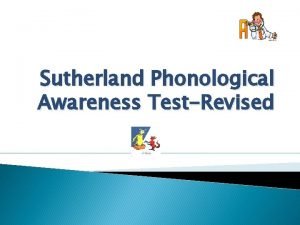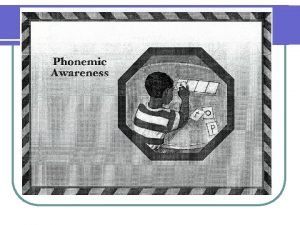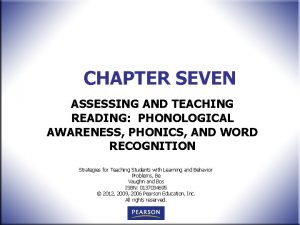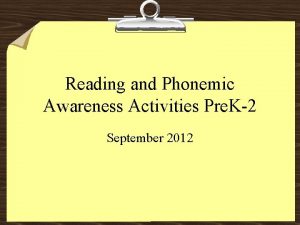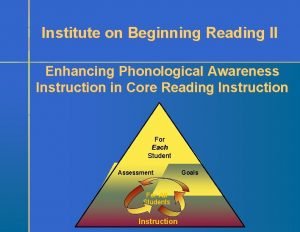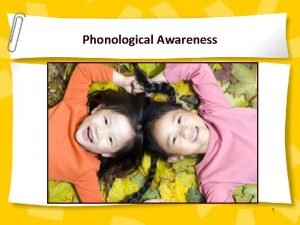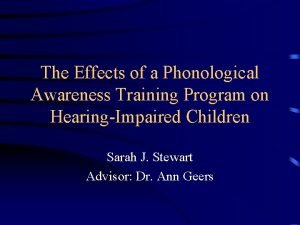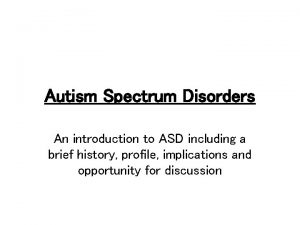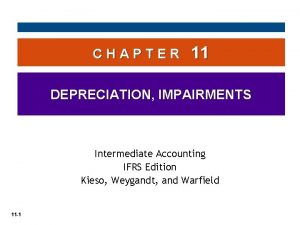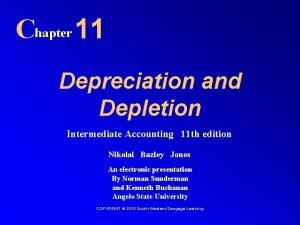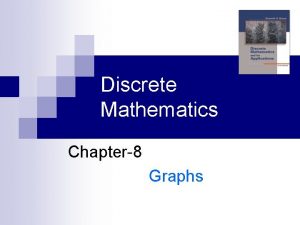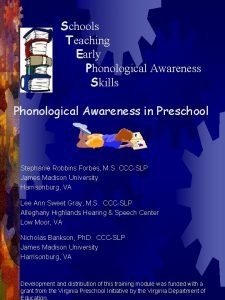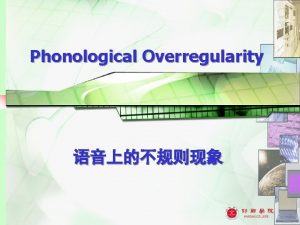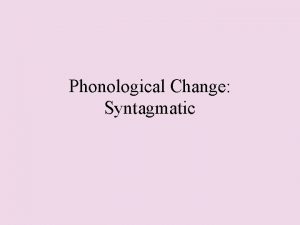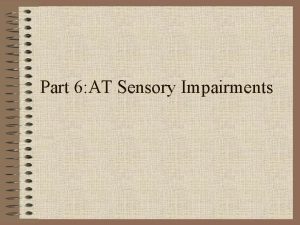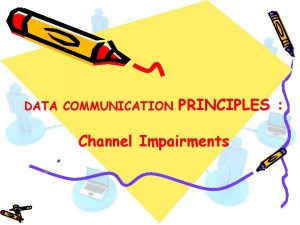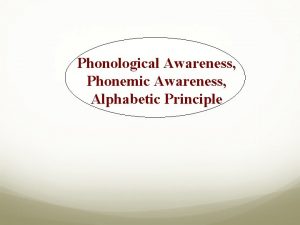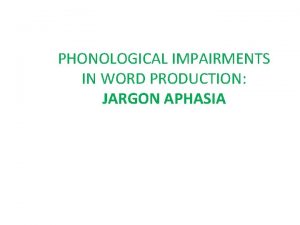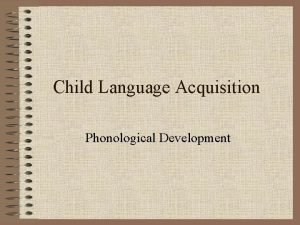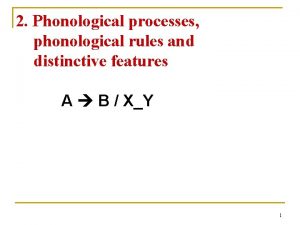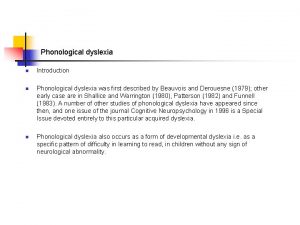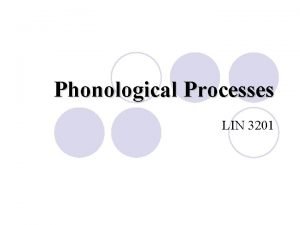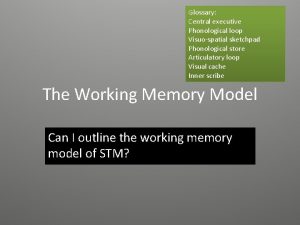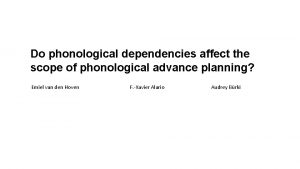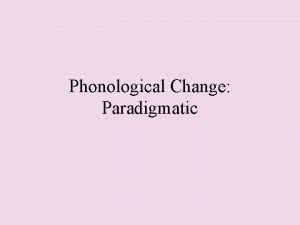Phonological Impairments Relation to Phonological Awareness Working Memory




















- Slides: 20

Phonological Impairment’s Relation to Phonological Awareness, Working Memory, and Literacy Monica Gordon Pershey, Ed. D. , CCC-SLP Department of Speech and Hearing Cleveland State University Cleveland, OH mgpershey@att. net Patricia A. Clickner, M. A. , CCC-SLP Lorain County Board of Mental Retardation and Developmental Disabilities Elyria, OH pclickner@loraincountymrdd. org

Background Developmental phonological impairment may arise from inadequate mental representations of speech sounds and/or difficulty accessing representations of speech sounds. Possibly 35% of children with phonological impairment evidence subsequent reading and spelling difficulties. Some children with phonological impairment may have difficulty acquiring phonological awareness, i. e. , the metalinguistic ability to reflect upon and manipulate speech sounds. Phonological awareness bootstraps onto the child’s speech system, with instabilities in the speech system potentially constraining phonological awareness. Strong and accurate internal phonological representations – meaning accurate speech sound productions – provoke the association of phoneme to grapheme, allowing reading and spelling to develop. The question remains whether it is weakness in phonological awareness alone that places children with phonological impairment at risk for reading and spelling difficulties. There is ample research evidence that a “double deficit” in two core processing deficits underlie reading disability: (1) undeveloped phonological awareness and (2) inadequate rapid naming of visual symbols. For children with phonological impairment, a proposed double deficit would involve (1) a weakness in internally representing and/or accessing speech sounds that impacts upon phonological awareness and that coexists with (2) difficulty rapidly retrieving names for visual symbols.

Background A Proposed Double Deficit for Children with Phonological Impairment: Some children with phonological impairment may have comorbid deficits in verbal working memory that manifest as difficulties with short term storage and manipulation of information that is encountered as auditory and/or verbal input. Verbal working memory span allows phonological and/or orthographic information to be “On Screen” for a long enough period of time for manipulations to be performed. Rapid naming of colors, letters, or numbers demonstrates verbal working memory. Rapid naming of letters reveals additional, separate cognitive-linguistic processes critical for learning to read. Each time a letter is encountered, it must be matched to letter templates or prototypes stored in visual memory and then matched to its name. Trouble rapidly naming letters shows deficiencies related to (a) orthographic representations (i. e. , difficulties with visual symbols that enter memory as icons which are then arbitrarily named and stored as semantic memory), and/or (b) adequate storage of visual information but inadequate semantic labels for the names of letters, and/or (c) interference from inadequate phonological representations, with instabilities in the speech system constraining knowledge of letter names and/or sounds. For children with phonological impairment, we must also rule out diminished naming speed that can be attributed to reduced articulatory proficiency.

Purpose The purpose of this study was to explore whether children with phonological impairment would show associated deficits in speech motor control, phonological awareness, verbal working memory, reading, and spelling. This research explored whether deficits in phonological awareness and rapid naming converged in a sample of children with phonological impairment and determined the combined impact of this “double deficit” on reading and spelling.

Research Questions Group Comparisons: Do children with phonological impairment evidence lower scores on tests of physiologically-based functions, namely suprasegmental quality of speech and oral motor control, than typically developing peers? Do children with phonological impairment evidence lower scores on cognitivelinguistic tasks that tax verbal working memory than typically developing peers? Do children with phonological impairment perform more poorly on rapid naming testing than typically developing peers? Do children with phonological impairment evidence lower scores on phonological awareness testing than typically developing peers? Do children with phonological impairment perform more poorly on reading testing than typically developing peers? Do children with phonological impairment perform more poorly on spelling testing than typically developing peers?

Research Questions Measures of Association Among Variables: Are deficits in physiologically-based functions, namely suprasegmental quality of speech and oral motor control, related to the presence of phonological impairment? Are deficits in cognitive-linguistic tasks that tax verbal working memory related to the presence of phonological impairment? Are deficits in rapid naming associated with phonological impairment? Are deficits in phonological awareness associated with phonological impairment? Are deficits in reading associated with phonological impairment? Are deficits in spelling associated with phonological impairment?

Methodology Participants Group 1 - 23 English-speaking children (12 in 1 st grade, 8 in 2 nd grade, 3 in 3 rd grade) diagnosed with phonological impairment Group 2 - 23 phonologically unimpaired peers (12 in 1 st grade, 8 in 2 nd grade, 3 in 3 rd grade) matched for race, gender, age (range 6. 4 9. 1), grade level, free lunch status, and IQ (normal range) From 10 elementary schools in one Midwest county, median household income $60, 000 All Group 1 and 2 students had passing scores for hearing acuity: Puretone air-conduction hearing screening at 20 db HL for 500, 1000, 2000, and 4000 Hz Groups 1 and 2 are significantly different due to level of phonological impairment as assessed by the Goldman-Fristoe Test of Articulation 2 (GFTA-2) (with findings used to compute Percentage of Consonants Correct); [ANOVA] F(1, 44) = 55. 16, p <. 0001

Methodology Three areas of capabilities were assessed for all participants. Administration of tests was conducted by the second author in randomized order over three individual testing sessions per child. Mean scores on all measures for groups 1 and 2 were computed. Area 1 - Physiological factors: To assess suprasegmental qualities of speech: A brief conversational sample analyzed for each participant for presence/absence of adequate quality; scored as “ 0" for normal, “ 1" for deviated 10% or less of the time, or “ 2" for deviated greater than 10% of the time To assess oral motor skills: Zelvis Oral Peripheral Screening - scored as “ 1" for normal diadochokinetic rate or “ 2" for abnormally slowed diadochokinetic rate for each participant

Methodology Area 2 - Cognitive-linguistic factors: To assess verbal working memory: The Clinical Evaluation of Language Fundamentals-3 (CELF-3) subtests for word forms (sentence recall allows child to generate needed syntax/grammar/morphology), following directions, sentence repetition; Standard scores obtained for each participant To assess rapid naming: The Comprehensive Test of Phonological Processes (CTOPP) Rapid Naming Subtests - colors, digits, letters, and non-words; Standard scores obtained for each participant To assess phonological awareness: CTOPP (Composite of Elision, Blending, Sound Matching subtests); Standard scores obtained for each participant

Methodology Area 3 - Reading and Spelling: Reading and Spelling subtests from The Kaufman Test of Educational Achievement (K-TEA) brief form; Standard scores obtained for each participant

Results Group Comparisons: Area 1 Do children with phonological impairment evidence lower scores on tests of physiologically-based functions, namely suprasegmental quality of speech and oral motor control, than typically developing peers? Suprasegmental Quality The difference between groups is significant [ANOVA] F(1, 44) =7. 48, p =. 009 Oral Motor Control 22% of Group 1 children had abnormal diadochokinetic performance The difference between groups is significant [ANOVA] F(1, 44) =6. 11, p =. 017

Results Group Comparisons: Area 2 Do children with phonological impairment evidence lower scores on cognitive-linguistic tasks that tax verbal working memory than typically developing peers? CELF-3 Word Forms The difference between groups is not significant [ANOVA] F(1, 44) =3. 67, p =. 062 CELF-3 Direction Following The difference between groups is not significant [ANOVA] F(1, 44) =3. 04, p =. 088 CELF-3 Sentence Repetition The difference between groups is significant [ANOVA] F(1, 44) =5. 55, p =. 023 CTOPP Non-word Repetition The difference between groups is significant [ANOVA] F(1, 44) =10. 39, p =. 002 Do children with phonological impairment perform more poorly on rapid naming testing than typically developing peers? CTOPP Rapid Naming mean composite standard score Group 1 45 th percentile average performance range Group 2 61 st percentile average performance range The difference between groups is significant [ANOVA] F(1, 44) =4. 72, p =. 035 Do children with phonological impairment evidence lower scores on phonological awareness testing than typically developing peers? CTOPP mean composite of standard scores for subtests Group 1 25 th percentile > 1 SD below norm Group 2 60 th percentile average performance range The difference between groups is significant [ANOVA] F(1, 44) = 28. 04, p <. 0001

Results Area 3 Do children with phonological impairment perform more poorly on reading testing than typically developing peers? K-TEA Reading standard score Group 1 34 th percentile < 1 SD below normative mean Group 2 74 th percentile < 1 SD below normative mean The difference between groups is significant [ANOVA] F(1, 44) =31. 72, p <. 0001 Do children with phonological impairment perform more poorly on spelling testing than typically developing peers? K-TEA Spelling standard score Group 1 37 th percentile < 1 SD below normative mean Group 2 68 th percentile < 1 SD below normative mean The difference between groups is significant [ANOVA] F(1, 44) =9. 84, p =. 003 “Just to be sure” - How different are these two groups? A Multivariate Analysis of Variance (MANOVA) compared groups based on all variables combined - speech physiology, phonological awareness, verbal working memory, rapid naming, reading, spelling The difference between groups is significant [MANOVA] F(1, 44) =14. 25, p <. 0001 MANOVA compared groups based on two variables combined - reading and spelling The difference between groups is significant [MANOVA] F(1, 44) =15. 58, p <. 0001

Results Measures of Association Among Variables for Children with Phonological Impairment Phonological impairment was associated with deficits in oral motor control and working memory, including rapid naming, but not phonological awareness, reading, or spelling Pearson Product Moment Correlations of Mean Scores - Percentage of Consonants Correct correlated with Other Variables Are deficits in physiologically-based functions, namely suprasegmental quality of speech and oral motor control, related to the presence of phonological impairment? Suprasegmental Quality - No Correlation Oral Motor Control - Significant Correlation r =-. 597, p =. 003 Lower Percentage of Consonants Correct scores were associated with higher (poorer) diadochokinetic scores, creating an inverse relationship Are deficits in cognitive-linguistic tasks that tax verbal working memory related to the presence of phonological impairment? CELF-3 Word Forms - Significant Correlation r =. 517, p =. 012 CELF-3 Direction Following – Significant Correlation r =. 612, p =. 002 CELF-3 Sentence Repetition – Significant Correlation r =. 464, p =. 026 CTOPP Non-word Repetition - No Correlation

Results Are deficits in rapid naming associated with phonological impairment? CTOPP Rapid Naming Composite - Significant Correlation r =. 405, p =. 05 Are deficits in phonological awareness associated with phonological impairment? CTOPP Phonological Awareness Composite - No correlation Are deficits in reading associated with phonological impairment? K-TEA Reading - No correlation Are deficits in spelling associated with phonological impairment? K-TEA Spelling - No correlation

Results Stepwise Regression Data Correlational data did not fully describe whether phonological impairment was associated with deficits in rapid naming (at p =. 05), phonological awareness, reading, and/or spelling Which test scores for children with phonological impairment accounted for variance in reading and spelling test scores? 41% of the variance in K-TEA Reading scores could be accounted for by performance on CTOPP Phonological Awareness Composite (p <. 001) 69% of the variance in K-TEA Reading scores could be accounted for by performance on CTOPP Phonological Awareness Composite and CTOPP Rapid Naming Composite scores as a combined independent variable (p <. 0001) [Coefficient analysis: PA at p <. 0001; RN at p =. 004 - indicates adequate stringency for each predictor variable] 64% of the variance in K-TEA Spelling scores could be accounted for by performance on CTOPP Phonological Awareness Composite (p =. 008) 49% of the variance in K-TEA Spelling scores could be accounted for by performance on CTOPP Rapid Naming Composite (p =. 012) Need to finally reduce to explained/unexplained variance: 66% of the variance in K-TEA Reading and Spelling scores as a combined dependent variable could be accounted for by performance on CTOPP Phonological Awareness Composite and CTOPP Rapid Naming Composite scores as a combined independent variable (p <. 0001) [Coefficient analysis: PA at p <. 0001; RN at p =. 009 - indicates adequate stringency for each predictor variable]

Conclusions The difference between children with phonological impairment and matched unimpaired children was significant for all measures except two verbal working memory tasks (not rapid naming). The presence of speech motor deficits was not ruled out. Phonological impairment correlated with poorer performance on speech motor tasks. Children with phonological impairment performed below the normative mean on tests of rapid naming, phonological awareness, reading, and spelling. Phonological impairment correlated with poorer performance on cognitivelinguistic tasks that tax verbal working memory and on rapid naming. Depressed rapid naming and phonological awareness coexisted as a “double deficit” in this sample of children with phonological impairment. Findings support prior research that children with reading deficits may have difficulties with verbal working memory. Findings support prior reports that children with phonological impairments may manifest deficits in verbal working memory, specifically rapid naming.

Conclusions Practical Applications Speech disturbances which render a child difficult to understand should not be dismissed as developmental motor skill. For children with phonological impairment who have weak phonological awareness and rapid naming, the double deficit hypothesis is applicable –– internal representations of speech sounds must be continually monitored and reinforced. All children with phonological impairment should be assessed by a speech-language pathologist and a reading specialist for deficits in rapid naming, phonological awareness, reading, and spelling. Intensive speech, language, and literacy interventions should be applied for children with coexisting phonological impairment and verbal memory deficits. Future Research Can research distinguish when deficient rapid naming ability reflects difficulties with verbal memory AND/OR difficulties with speech motor control? Studies need to separate these performance components to isolate the memory vs motor aspects of rapid naming. Can research establish subtypes of phonological impairment, as in with verbal memory impairment, with speech motor impairment, or with both? Research is needed to explore any and all connections between phonological impairment and literacy acquisition.

References Bird, J. , Bishop, D. V. M. , & Freeman, N. H. (1995). Phonological awareness and literacy development in children with expressive phonological impairments. Journal of Speech and Hearing Research, 38, 446 -462. Bishop, D. M. V. , & Adams, C. (1990). A prospective study of the relationship between specific language impairment, phonological disorders and reading retardation. Journal of Child Psychology and Psychiatry, 31, 1027 -1050. Catts, H. W. (1991). Phonological processing deficits and reading disabilities. In A. G. Kahmi & H. W. Catts (Eds. ), Reading disabilities, A developmental language perspective (pp. 67 -99). Needham Heights, MA: Allyn & Bacon. Lewis, B. A. , Freebairn, L. , & Taylor, H. G. (2000). Academic outcomes in children with histories of speech sound disorders. Journal of Communication Disorders, 33, 11 -30. Lewis, B. A. , Freebairn, L. , & Taylor, H. G. (2002). Correlates of spelling abilities in children with speech sound disorders. Reading & Writing: An Interdisciplinary Journal, 15, 389 -407. Lovett, M. , W. , Steinbach, K. A. , Frijters, J. C. (2000). Remediating the core deficits of developmental reading disability: A double deficit perspective. Journal of Learning Disabilities, 334 -359. Manis, F. R. , Seidenberg, M. S. , & Doi, L. M. (1999). See Dick RAN: Rapid naming and the longitudinal prediction of reading subskills in first and second graders. Scientific Studies of Reading. 3, 129 -157. National Institute on Deafness and Other Communication Disorders (NIDCD). (2000). Incidence and prevalence of speech, voice, and language disorders in the United States. Bethesda, MD: NICD. Retrieved October 5, 2002, from http: //www. nih, gov/nidcd/health/vsl. htm Schatschneider, C. , Calrson, C. D. , Francis, D. J. , Foorman, B. R. , & Fletcher, J. M. (2002). Relationship of rapid automatized naming and phonological awareness in early reading development: implications for the double-deficit hypothesis. Journal of Learning Disabilities. 35, 245 -256. Shankweiler, D. , & Liberman, I. Y. (1992). Phonology and reading disability. Ann Arbor, MI: The University of Michigan Press. Shriberg, L. , Kwiatkowski, J. , Best, S. , Hengst, J. , & Terselic-Weber, B. (1986). Characteristics of children with phonologic disorders of unknown origin. Journal of Speech and Hearing Disorders, 51, 140 -161. Shriberg, L. , & Kwiatkowski, J. (1994). Developmental phonological disorders I: A clinical profile. Journal of Speech and Hearing Research, 37, 1100 -1126. Stackhouse, J. , & Wells, B. (2001). Children’s speech and literacy difficulties: A psycholinguistic framework. London, England: Whurr Publishers Ltd. Torgesen, J. K. (1999). Assessment and instruction for phonetic awareness and word recognition skills. In Kamhi, A. & Catts, H. (Eds. ), Reading dsabilities, A developmental language perspective. (pp. 128 -153). Needham Heights, MA: Allyn & Bacon. U. S. Census Bureau. (2000). American factfinder. Washington, D. C. : Author. Retrieved September 20, 2002, from http: //factfinder. census. gov Wagner, R. K. , Torgesen, J. K. , & Rashotte, C. A. (1999). Comprehensive Test of Phonological Processing (CTOPP). Austin, TX: Pro-Ed. Webster, P. E. , & Plante, A. S. (1992). Effects of phonological impairment on word, syllable, and phoneme segmentation and reading. Language, Speech, and Hearing Services in Schools, 23, 176 -182. Webster, P. E. , & Plante, A. S. (1995). Productive phonology and phonological awareness in preschool children. Applied Psycholinguistics, 16, 43 -57. Webster, P. E. , Plante, A. S. , & Couvillion, L. M. (1997). Phonologic impairment and prereading: Update on a longitudinal study. Journal of Leaning Disabilities, 30, 365 -375. Wolf, M. , Goldberg O’Rourke, A. , Gidney, C. , Lovett, M. , Cirino, P. , & Morris, R. (2002). The second deficit: An investigation of the independence of phonological and naming-speed deficits in developmental dyslexia. Reading and Writing: An Interdisciplinary Journal, 15, 43 -72.

 Sutherland phonological awareness test
Sutherland phonological awareness test Emma elkonin
Emma elkonin Phonological continuum
Phonological continuum What is letter sound relationship
What is letter sound relationship Phoneme identity activities
Phoneme identity activities Blending examples
Blending examples Phonological awareness continuum chart
Phonological awareness continuum chart Phonological awareness training program
Phonological awareness training program Which memory is the actual working memory?
Which memory is the actual working memory? Wings triad
Wings triad Kunci jawaban buku intermediate accounting ifrs chapter 11
Kunci jawaban buku intermediate accounting ifrs chapter 11 Component depreciation
Component depreciation Intermediate accounting chapter 11
Intermediate accounting chapter 11 Enumerate and explain the different modifiers of human acts
Enumerate and explain the different modifiers of human acts Cvs privacy awareness and hipaa training answers
Cvs privacy awareness and hipaa training answers Differentiate between hot working and cold working
Differentiate between hot working and cold working Smart work vs hard work
Smart work vs hard work Proses pengerjaan logam
Proses pengerjaan logam Hot and cold working process
Hot and cold working process Hot working and cold working difference
Hot working and cold working difference Directed pseudograph
Directed pseudograph
